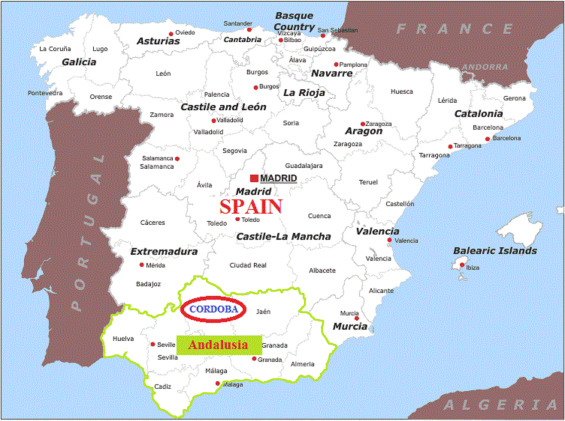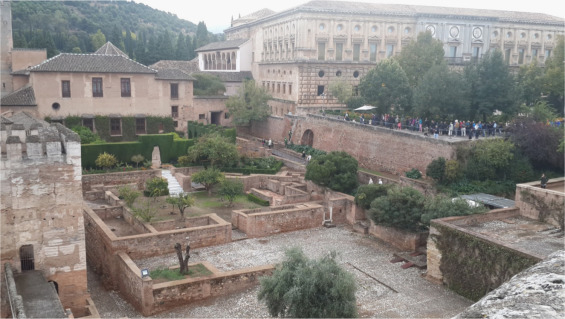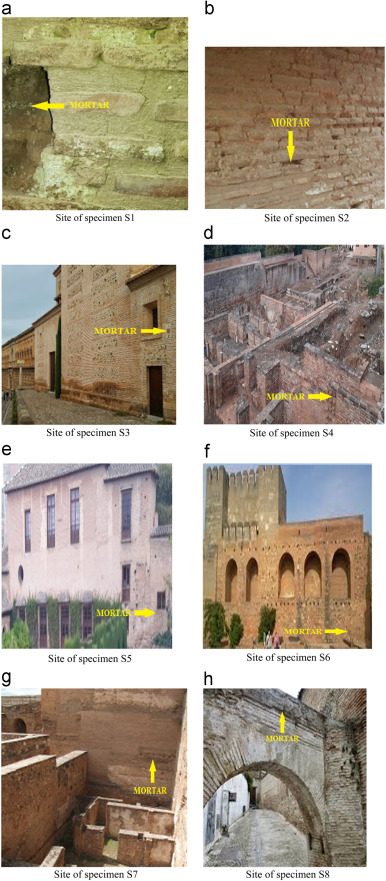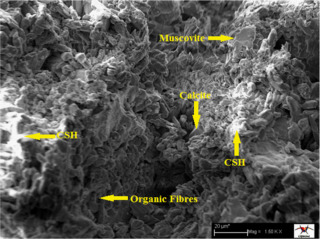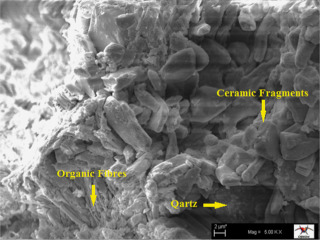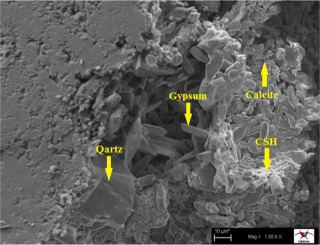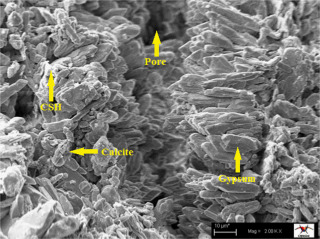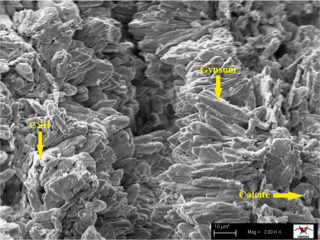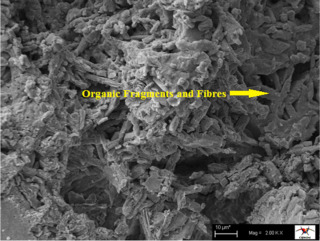Abstract
Al-Andalus mortar is an ancient binding material (lime mortar) that was used for centuries in numerous historical buildings in Al-Andalus, Granada (Spain). The physico-chemical and microscopic properties of Al-Andalus mortars in Granada were studied as part of an investigation into the mineral raw materials present in the territory of Spain. Scanning electron microscope and X-ray diffraction analyses of eight main types of mortars were performed to show the presence of calcite, gypsum, quartz, and muscovite minerals with organic fibers. Chemical analyses of the specimens showed that high SiO2 +Al2 O3 +Fe2 O3 contents yielded high values of hydraulicity and cementation indices. A significant result of this study was that mortars with high hydraulicity and cementation indices have high mechanical strengths. This characteristic may be the main reason for the earthquake resistance of the historical Alhambra Palace.
Keywords
Al-Andalus mortars ; Alhambra Palace ; Microscopic properties
1. Introduction
The Alhambra Palace was first constructed in 1236 by the last Muslim emirs (kings) in Spain and the Nasrid Dynasty. Later, in the 16th century, the Palace was renovated and modified for King Charles V (Figure 1 ; Figure 2 ). Consequently, European features intermingle with some of the finest examples of Moorish architecture in the world. Alhambra Palace incorporates many traditional Islamic details, such as column arcades, fountains, reflecting pools, geometrical patterns, Arabic inscriptions, and painted tiles. For many centuries, the maintenance of Alhambra Palace was neglected. Scholars and archeologists began restorations in the 19th century, and today, the Palace is a major touristic attraction and a UNESCO World Heritage site since 2007 (Jones, 2014 ; Mojtaba, 2009 ; Suarez and Bravo, 2014 ). Although the urbanization of Granada and the immense pressure of mass tourism raise the concerns of preventive conservators, the atmospheric risks related to the conservation of the Palace have yet to be sufficiently evaluated. In one of the few studies conducted to determine the indoor and outdoor air quality of the Alhambra monument, the application of complementary analytical chemical techniques was carried out to formulate a strategy for the preventive conservation of the monument (López et al ., 1996 ; Horemans et al ., 2011 ; Sarró et al ., 2006 ). Some studies were recently conducted on pilot applications with compatible restoration mortars, which avoids the common practice of cement mortar mixtures (Cultrone et al ., 2007 ; Binici et al ., 2010 ; Boynton, 1980 ). The aim of the present study is to draw attention to the general resistance by investigating the physico-chemical and microscopic properties of masonry mortars from Alhambra Palace (Spain). The performance of Alhambra Palace against earthquake damage is dependent, to a large extent, on the physical characteristics of its mortars. Hence, compressive strength (durability) is a crucial parameter in the load capacity of structures and is, therefore, included in the present study.
|
|
|
Figure 1. Map of the Andalusian state and location of Cordoba in Spain. |
|
|
|
Figure 2. General view of Alhambra Palace. |
2. Materials and methods
2.1. Materials
Eight mortar samples were selected from the scrap materials of mortars from the walls of eight buildings prepared for restoration in Alhambra Palace in Granada, Spain (Figure 3 ). These mortar specimens contain broken bricks, limestone, and crushed ceramic fragments as coarse material additives, together with organic additives (lightweight particles) that were observed by the naked eye and an ordinary magnifier (Table 1 ). The different colors of the patina and interiors of these fragments were determined using the NH310 Portable Color Measurement Device via the RGB and hexadecimal system (Table 2 ). The proportion of lightweight particles (organic/straw fragments, etc.) present in the aggregates was determined according to Turkish standard specifications EN TS 3528.
|
|
|
Figure 3. (a) Site of specimen S1. (b) Site of specimen S2. (c) Site of specimen S3. (d) Site of specimen S4. (e) Site of specimen S5. (f) Site of specimen S6. (g) Site of specimen S7. (h) Site of specimen S8. |
| Specimens | Additives–coarse materials (by magnifier) | Binder (by XRD) | Light weight marerials | |
|---|---|---|---|---|
| particles | (vol%) | |||
| S1 | Brick and limestone fragments | Calcite, muscovite | Organic fragments | 0.25 |
| S2 | Brick and crushed ceramic fragments | quartz, muscovite | Organic fibers | 0.23 |
| S3 | Brick and crushed ceramic fragments | Calcite, quartz, muscovite | Organic fibers | 0.31 |
| S4 | Brick and crushed ceramic fragments | Calcite, muscovite | Organic fragments | 0.23 |
| S5 | Brick and crushed ceramic fragments | Calcite, quartz, | – | 0.32 |
| S6 | Brick and limestone fragments | Calcite, muscovite | Organic fibers | 0.24 |
| S7 | Brick and crushed ceramic fragments | quartz, muscovite | Organic fibers | 0.26 |
| S8 | Brick and crushed ceramic fragments | Calcite, quartz, | Organic fibers | 0.30 |
| Specimens | Locations/functional component | Patina color | Interior color |
|---|---|---|---|
| S1 | The wall of cook room | Dim gray 105 105 105; # 696969 | White smoke 245 245 245; # f5f5f5 |
| S2 | The outer wall of the palace | Dark gray 102 102 102; # 666666 | Medium gray 128 128 128; # 808080 |
| S3 | The wall of madrasah | Broken White 242 242 242; # f2f2f2 | White smoke 245 245 245; # f5f5f5 |
| S4 | The column of the palace baths | Dark gray 102 102 102; # 666666 | Medium gray 128 128 128; # 808080 |
| S5 | The walls of the palace housing | Dim gray 105 105 105; # 696969 | White smoke 245 245 245; # f5f5f5 |
| S6 | The walls of the palace guard tower | Dim gray 105 105 105; # 696969 | White smoke 245 245 245; # f5f5f5 |
| S7 | The walls of the palace library | Dark gray 144 143 143; # 908f8f | Medium gray 128 128 128; # 808080 |
| S8 | The brick arches of the palace exit door | Dim gray 105 105 105; # 696969 | Ghost white 248 248 255; # f8f8ff |
The main elemental contents in the Alhambra Palace mortars are given in Table 3 . Depending on the colors and types of aggregates, the specimens were separated into eight groups. Samples from each group were used for chemical and microscopic analyses and compressive strength tests. The major elements Ca, Mg, Fe, and Al were measured by atomic absorption spectrometry (AAS) after HCl (1 N) treatment. The amount of soluble SiO2 (not equal to the total amount) was estimated based the dissolution of the specimens in HCl (3 N) and the analysis by atomic emission spectrometry (AES). The elemental amounts are related to the degree of hydraulicity of the mortars as suggested by EN TS 3624, with high indices indicating high hydraulicities.
| Elements | LLD | Specimens | |||||||
|---|---|---|---|---|---|---|---|---|---|
| S1 | S2 | S3 | S4 | S5 | S6 | S7 | S8 | ||
| Fe2 O3 | 0.1 | 5.35 | 5.13 | 5.23 | 5.41 | 5.32 | 5.14 | 4.99 | 4.87 |
| Al2 O3 | 0.2 | 7.25 | 7.32 | 7.54 | 7.35 | 7.30 | 7.22 | 7.43 | 7.27 |
| SiO2 | 0.1 | 42.23 | 41.25 | 44.35 | 41.24 | 44.23 | 41.09 | 42.28 | 43.88 |
| Na2 O | 0.1 | 0.62 | 0.65 | 0.69 | 0.71 | 0.73 | 0.66 | 0.72 | 0,66 |
| K2 O | 0.2 | 1.36 | 1.28 | 1.20 | 1.33 | 1.24 | 1.29 | 1.27 | 1.21 |
| CaO | 0.1 | 30.30 | 30.28 | 27.25 | 30.50 | 27.65 | 30.35 | 30.02 | 29.04 |
| MgO | 0.1 | 0.85 | 0.81 | 0.87 | 0.92 | 0.97 | 0.80 | 0.82 | 0.70 |
| MnO | 0.01 | 0.02 | 0.01 | 0.01 | 0.02 | 0.01 | 0.01 | 0.01 | 0.01 |
| P2 O5 | 0.1 | 0.45 | 0.47 | 0.51 | 0.43 | 0.52 | 0.44 | 0.49 | 0.25 |
| LOI | 0.1 | 12.57 | 11.80 | 12.36 | 12.19 | 12.06 | 13.01 | 12.04 | 12.18 |
| SiO2 + Al2 O3 + Fe2 O3 | 54.83 | 53.70 | 57.12 | 54.00 | 56.85 | 53.45 | 54.70 | 56.02 | |
| Total | 100.0 | 100.0 | 100.0 | 100.0 | 100.0 | 100.0 | 100.0 | 100.0 | |
| HI (hydraulic index) | 1.760 | 1.727 | 2.031 | 1.718 | 1.986 | 1.715 | 1.773 | 1.883 | |
| CI (cementation index) | 4.127 | 4.047 | 4.782 | 4.006 | 4.674 | 4.022 | 4.172 | 4.472 | |
2.2. Electron microscopy
Selected mortar prisms were cut into cubes approximately 10×10×10 mm3 in size, one side of which was polished flat. The samples were then placed in a vacuum dessicator for a minimum period of three days. Polished surfaces were coated with gold using a BIO-RAD Polar Division SEM coating system. The microstructure of the specimens was studied in a Philips XLS 30 SEM. The submicroscopic pore and aggregate characterizations of the mortars, namely, size, shape, and orientation, were interpreted using the micromorphological approach developed by FitzPatrick, 1993 ; Kelling et al ., 2000 ).
2.3. X-ray powder diffraction analysis
X-ray diffraction (XRD) analysis was conducted using a Bruker D8 diffractometer with a general area diffraction detector and an 800 mm collimator with a pinhole from 2.2° to 90° 2θ using Co Ka radiation with a wavelength λ =1.79026 Å, generated at 40 keV and 20 mA. Diffraction patterns were compared with ICDD PDF card files to identify mineral species, which were then obtained using a laser-focusing system that allows nondestructive spot XRD analysis of the mineral of interest on the rock samples.
2.4. Chemical assessment methods
The chemical composition of the Al-Andalus mortars was determined by a number of complementary methods according to the Turkish Standard EN TS 196-2 presented in weight percentage. Sample materials were pulverized and subsequently absorbed in excess concentrated hydrochloric acid (1 N HCl). Na and K were measured separately in a Jenway PFP 7 flame photometer. Ca, Mg, Fe, and Al were measured by AAS. Analysis of the Mn2 O5 and P2 O5 was undertaken by XRF. Loss on ignition was determined at 1000 °C. The amount of soluble SiO2 (different from the SiO2 total) was estimated by dissolution in excess 3 N HCl and subsequent analysis by AES. Furthermore, the SiO2 analysis was conducted using a gravimetric method by determining the insoluble residue by weight. The remaining components were then determined by EDTA titration. Hydraulicity and cementation indices were recalculated using equations developed by Boynton (1980) .
2.5. Physical and mechanical assessment methods
The specimens used for the compressive strength test were 40×40×40 mm3 in size. The density, specific porosity, and water absorption of the specimens were calculated using the Archimedes principle on same-sized cubes (RILEM, 1980 ). Aggregate types and lightweight particle contents of the mortars were tested according to the EN TS 196-1. Compressive strength tests were performed using a 20,000 kN capacity automatic compression machine according to EN TS 24 by obtaining the average strength of the three parallel measurements of each specimen. Total porosity was determined according to the water saturation test with a hydrostatic balance (Clemena, 1972 ).
2.6. Quantity of cementation and sand in mortar
Various chemical and nuclear methods have been developed to determine the cement content of sample concrete. However, each of these methods has undesirable features that prevent its wide acceptance (Clemena, 1972 ). The ASTMC-642 method (ASTM ) consists of determining the amount of soluble silica and calcium oxide in a sample by chemical analysis. The method enables the indirect calculation of the percentage of cement by assuming or establishing certain definite concentrations of silica and calcium oxide in the cement used from the analyses of the original cement. The method yields reliable results, particularly if samples of the original cement and aggregates are available. However, it is time consuming and is not applicable to concrete containing aggregates that simultaneously yield significant amounts of silica and calcium oxide under test conditions.
Contemporary chemical methods are insufficient to determine the cement content of hardened concrete related to the errors in gravimetric determination of soluble silica (Gomà et al., 2010 ). Thus, a new procedure is employed in the present study, which has a lower standard deviation compared with the existing methods. The procedure also eliminates errors in the gravimetric determination of silica. This new method allows more accurate results on the water/cement ratio to be obtained. The method concerns the conversion of the soluble silica form to insoluble by progressive dehydration and evaporation to dryness, during which the silicic acids must be in a completely polymerized amorphous state.
3. Results and discussion
3.1. SEM and XRD
The SEM images reveal the presence of calcite and amorphous CSH phases (Figure 4 , Figure 5 , Figure 6 , Figure 7 , Figure 8 ; Figure 9 ) determined as the major components of the mortar admixtures, commonly known as “lime mortars” (Table 2 ).
|
|
|
Figure 4. SEM image of specimen S1. |
|
|
|
Figure 5. SEM image of specimen S3. |
|
|
|
Figure 6. SEM image of specimen S5. |
|
|
|
Figure 7. SEM image of specimen S6. |
|
|
|
Figure 8. SEM image of specimen S7. |
|
|
|
Figure 9. SEM image of specimen S8. |
XRD analysis revealed the presence of muscovite and quartz, which were masked by the abundant calcite binder and the amorphous hydraulic formations determined in the SEM images (Table 1 ). Frequent to occasional organic fibers (1–3 mm) and fragments (1–5 mm) were identified in the matrices of the S1, S2, S3, and S4, and S6 and S7 specimens, respectively, by the magnifier (Table 1 ), while frequent fine organic fibers/fragments were identified only in S8 and occasionally to rare in the S1 and S3 specimens by SEM images (Figure 4 ; Figure 5 respectively). The frequent straw fragments in S8 were partly decomposed materials that were in good edge-to-edge and edge-to-surface contact with the elongated calcite and fine coated gypsum crystals (Figure 9 ). The organic fibers/fragments in S3 appear to contribute to the development of welded aggregates composed of dominant quartz, irregular broken ceramic fragments, degraded mica (muscovite), and partly decomposed/degraded organic fibers. Gypsum grains form in random orientation as infills in the elongated pores of specimen S5 (Figure 6 ), where the CSH structures are most likely responsible for the welding of aggregates that form parallel to the pore walls (Figure 8 ) and the aggregate surfaces (Figure 7 ). Degraded muscovite grains are also welded with calcite, quartz, and by CSH structures in S7 and S8 (Figure 8 ; Figure 9 respectively). The welded aggregates of specimens S3 and S5 are composed of dominant quartz, irregular broken ceramic fragments (frit), and degraded mica (muscovite) with organic fragments (straw) in the former and calcite, quartz, gypsum, and organic fragments in the latter (Figure 5 ; Figure 6 respectively). The images also reveal continuous elongated pore structures with pore widths of approximately 10–30 µ complemented by an almost equal distribution of smaller closed pores (discontinuous pores) of 5–30 µ size in specimens S5, S6, S7, and S8. The irregular pore spaces are heterogenously distributed and embedded in the intermatted-welded aggregates of calcite and the irregular CSH structures of specimens S1 and S8 (Figure 4 ; Figure 9 respectively). Parallel welded calcite and gypsum grains along a vertical axis form elongated pore walls by elongated aggregates (of over 100 µ vertical length) on both sides of pore spaces in S5, S6, and S7 (Figure 6 , Figure 7 ; Figure 8 , respectively). The aggregates composed of quartz, irregular ceramic fragments, and degraded mica in specimen S3 and the aggregates composed of calcite and muscovite in specimen S8 are reinforced by the occasional to frequent organic fragments and fibers (Figure 5 ; Figure 9 respectively). The average grain size of the abundant calcite crystals aggregated with the CSH structures is 5–30 µ, with minor differences between mortars from different structures.
The dominant elements (oxides) of the Al-Andalus mortars conducted by EDS on specimens (Table 3 ) were calcium, silica, aluminum, and iron. The abundant contents of these elements, together with the CSH-welded aggregates of calcite, muscovite, gypsum, and broken ceramic fragment-rich matrices of the Al-Andalus mortars (especially S3) are most likely the cause of their compressive strength. The reinforced elongated pores (pore walls) by gypsum and calcite infills may also be the reason for the increased compressive strength in specimen S5, together with the welded elongated pore surfaces and pore spaces (Table 4 ).
| Specimens | Compressive strength (MPa) (Durability) | Water absorption after 24 h (%) | Density (g/cm3 ) | Porosity (%) |
|---|---|---|---|---|
| S1 | 12.44 | 14.08 | 1.87 | 34.17 |
| S2 | 13.25 | 15.02 | 1.92 | 33.25 |
| S3 | 15.87 | 11.06 | 2.11 | 30.04 |
| S4 | 11.44 | 14.11 | 2.04 | 32.44 |
| S5 | 15.39 | 12.78 | 2.23 | 30.87 |
| S6 | 12.55 | 13.54 | 1.91 | 34.59 |
| S7 | 13.14 | 11.41 | 2.21 | 31.24 |
| S8 | 12.27 | 13.11 | 1.97 | 32.12 |
3.2. Chemical compositions
Chemical composition data in wt% oxides for all six sample locations are shown in Table 3 . The results reveal remarkably uniform compositions for mortars from very different structures, almost spanning 500 years throughout history. Many authors have attempted to determine the hydraulicity of ancient mortars on the basis of the combined results of chemical and microscopical analyses (Banfill and Forrester, 2000 ; Franzini et al ., 2000 ; Callebaut et al ., 2001 ; Middendorf et al ., 2000 ; Bohm, 2000 ; Martinet and Quenee, 2000 ; Van Balen et al ., 2000 ). The hydraulic properties of the studied mortars were determined by calculating the hydraulic (HI) and cementation (CI) indices that consider the chemical compositions of white lumps according to the Boynton formula. The highest values for the hydraulicity and cementation indices correspond to the highest SiO2 , Al2 O3, and Fe2 O3 contents of specimens S3, S5, and S8, respectively.
3.3. Physical properties
Data on the physical properties are shown in Table 4 . The content of lightweight particles in modern mortars is limited, according to Turkish standard EN TS 3528. Thus, mortars are considered durable when the content of lightweight particles is less than 0.5 vol%, whereas contents higher than 0.5 vol% are considered poorly durable (Temiz et al., 2006 ). S3 contains brick fragments and crushed ceramics (Table 4 ) and is observed to have the highest compressive strength. Other specimens containing limestone fragments along with other ingredients mentioned show low compressive strength. According to the water absorption data, specimen S3 also has the lowest porosity value and the highest HI and CI indices. In comparison, S6 containing brick and limestone fragments attained the highest porosity and the lowest HI and CI indices.
3.4. Quantity of cementation and sand in mortar
The studied mortars were analyzed according to Gomà’s method (Gomà, 2007 ). Cementation and sand in mortar show similar ratios (Table 5 ). The results obtained by the use of Gomà’s method proved to be useful in interpreting the hydraulic characters of the ancient mortars. The formation of hydraulic (silica hydrates) and cementation compounds at the interface was most probably due to the reactions between the broken bricks and aggregates. This process is most probably similar to the one that had occurred within the highly cementitious brick–lime mortars of the dome of Hagia Sophia. Such similarity explains the fact that the monument still stands by absorbing the energy derived from earthquakes without affecting the material properties (Temiz et al., 2006 ).
| Spec. | Content | |||||
|---|---|---|---|---|---|---|
| SiO2 (aggregate) % | SiO2 (cementation) % | TotalSiO2 (mortar) % | Xi of cementation content (kg/m3 ) | Max.cementation content (kg/m3 ) | Min.cementation content (kg/m3 ) | |
| S1 | 0.13 | 22.40 | 2.66 | 265 | 271 | 259 |
| S2 | 0.15 | 22.32 | 2.58 | 264 | 270 | 258 |
| S3 | 0.19 | 24.45 | 2.71 | 271 | 279 | 264 |
| S4 | 0.14 | 22.15 | 2.72 | 261 | 270 | 255 |
| S5 | 0.18 | 23.32 | 2.63 | 267 | 273 | 258 |
| S6 | 0.14 | 22.47 | 2.61 | 266 | 275 | 259 |
| S7 | 0.15 | 21.74 | 2.64 | 263 | 273 | 257 |
| S8 | 0.20 | 23.04 | 2.73 | 269 | 275 | 265 |
4. Discussion
4.1. Microscopy, mineral contents, and chemical composition
The oxide composition analysis by EDS of the Al-Andalus mortar used in the historical buildings in Alhambra Palace indicated that all the mortars are mainly composed of high amounts of Si and Ca and moderate amounts of Fe, Na, and K (Table 3 ). However, the amounts of Fe in all mortars used in the historical buildings were found to be more or less the same (Table 3 ). Abundant calcite grains welded by amorphous hydraulic formations (CSH) into cluster aggregates were determined in the matrix of the mortars, especially in specimens S3, S5, and S8 (Figure 5 , Figure 6 ; Figure 9 , respectively). This finding reflected the use of finely ground abundant limestone fragments as the main ingredient of the mortars. These fragments were most likely recrystallized as fine calcite and CSH aggregates and oriented as cluster aggregates following the hydration/welding process. The elongated and irregular pores observed in the SEM images to be heterogenously distributed in the welded/hydrated matrices of the specimens are most likely caused by the heterogenous distribution of the hydration products. Specifically, these pores most probably indicate a non-uniform proceeding hydration process, and are mainly composed of calcite and CSH in specimen S1 of the lowest density and the highest porosity next to specimens S3 and S6 (Moropoulou et al ., 2002 ; Moropoulou et al ., 2006 ). Muscovite was most probably the constituent of one of the source materials, namely, the brick, ceramic, and limestone fragments added to the mortar mixtures (Table 1 ). The mineral constituents from the source materials, together with the secondary calcite grains and the amorphous CSH phases formed during the welding/hydration process, were probably responsible for the development of strong adhesion bonds and the durability of the lime mortars (Figure 5 ). The absorbent properties of the CSH amorphous phases that formed in the matrix of the mortars were most likely one of the primary reasons for the earthquake resistance of the structures, as earlier stated by Moropoulou et al. (2002) to be valid for other Byzantine buildings. The presence of frequent organic fragments and fibers may also indicate an incremental increase in mortar durability in S3 and S5. The formation of hydraulic compounds, such as calcium silicate hydrates and calcium aluminate hydrates, at the interface was most probably due to the reactions between the broken bricks, crushed ceramics, and welded aggregates by CSH structures in specimens S3, S5, and S8. Similar to the highly cementitious nature of the crushed brick–lime mortars of the Hagia Sophia dome, a nature that explains how the monument still stands by absorbing the energy derived from earthquakes without affecting the material properties (Moropoulou et al., 2002 ). The results indicated that the increase in use of the additive type and content caused a significant increase in the durability of the Al-Andalus mortars. This finding is contrary to the lime mortars of the Noto Cathedral in Milan, Italy, which have low cohesion and adhesion because the stones are friable and non-durable.
4.2. Physical and mechanical properties
Compressive strength is a main physical property reflecting the quality of mortars. It depends on the type of additives used and the density–porosity of the mortars. Specimen S3 has the highest compressive strength, most likely due to the high hydraulicity and cementation indices of the specimen. The compressive strength characteristics of the mortars were affected not only by the additive types but, in some cases, by organic fibers and muscovite flakes behaving as short fibers. Fibers oriented in the longitudinal and transverse directions prevent deformations in the matrix and preserve the shape of the mortars by their stress resistance. The fibers also prevent the mortar near the surface from being crushed and falling off. Fibers in the mortar prevent the transverse expansion caused by Poisson׳s effect (Campbell, 2010 ; Binici et al ., 2005 ). The existence of these fibers increases the elasticity of the mortar. Some ancient mortars have been durable for centuries, depending on whether or not they contain hydraulic components, i.e., binder. Thus, our study proves that mortars with high hydraulicity and cementation indices have high compressive strengths.
4.3. Cementation materials in mortar
Al-Andalus mortars are typical hydrated lime mortars, in which the predominant binder is hydrated lime. These are the crushed brick–lime mortars with medium hydraulic binder contents, where lime is mixed with small fragments of ceramic materials. The additive aggregates are of marine-beach origin in the case of the Alhambra Palace mortars (S3, S4, and S6), and the others originate from fluvial (river) sources (Baronio et al ., 2003 ; Binda et al ., 2003 ). Consequently, Al-Andalus mortars are highly durable, not only because of the appropriate materials used to produce them, but also in the construction of the structures, i.e., in the packing of the mortar and the use of appropriate types/mixtures of mortars in the different components of the buildings.
5. Conclusions
Islamic architectural design and construction combine various secular and religious styles that span the Islamic history. The bulk of Islamic architectural characteristics is visible in mosques, tombs, forts, and palaces, though the evolution of Islamic architecture can be best seen in the construction of mosques. The following conclusions can be drawn from this study concerning the analysis of the physico-chemical and microscopic properties of the masonry mortars from Alhambra Palace (Spain):
- The broken bricks, as appropriate puzzolanic materials, with organic fibers and fragments, the muscovite mineral contents, the recrystallized calcite, the CSH amorphous phases (calcite+CSH aggregates), and the consistent continuous–discontinuous pore distributions of the mortar matrices are most probably responsible for the high mechanical strength of the mortars. EDS indicated that the oxide composition of the Al-Andalus mortars is generally composed of high amounts of Si, Ca, and subordinate amounts of Fe, Na, and K.
- The high SiO2 +Al2 O3 +Fe2 O3 contents are most likely responsible for the high compressive strengths in all the specimens.
- Specimen S3, which has the highest durability and lowest water absorption and porosity, was the mortar from the most intact building in the mosque complex. This result is most likely due to the crushed ceramic content of S3. In contrast, mortars with limestone contents yielded slightly lower compressive strengths. However, both limestone and crushed ceramic containing mortars have high compressive strengths, which reveal the earthquake resistance of the masonry buildings.
Acknowledgment
The authors would like to thank Mehmet AKCAN for his invaluable contribution to this study.
References
- ASTM, ASTMC-462 . Standard Method of Test for Cement Content in Hardened Portland Cement Concrete.
- Banfill and Forrester, 2000 Banfill, P.F.G., Forrester, A.M., 2000. A relationship between hydraulicity and permeability of hydraulic lime. In: Proceedings of the International RILEM Workshop Historic Mortars: Characteristics and Tests. Paisley, pp. 173–83.
- Baronio et al., 2003 G. Baronio, L. Binda, C. Tedeschi, C. Tiraboschi; Characterisation of the materials used in the construction of the Noto Cathedral; Constr. Build. Mater., 17 (8) (2003), pp. 557–571
- Binda et al., 2003 L. Binda, G. Baronio, C. Tiraboschi, C. Tedeschi; Experimental research for the choice of adequate materials for the reconstruction of the Cathedral of Noto; Constr. Build. Mater., 17 (8) (2003), pp. 629–639
- Binici et al., 2005 H. Binici, O. Aksogan, T. Shah; Investigation of fibre reinforced mud brick as a building materials; Constr. Build. Mater., 19 (4) (2005), pp. 313–318
- Binici et al., 2010 H. Binici, J. Arocena, S. Kapur, O. Aksogan, H. Kaplan; Investigation of the physico-chemical and microscopic properties of Ottoman mortars from Erzurum (Turkey); Constr. Build. Mater., 24 (10) (2010), pp. 1995–2002
- Bohm, 2000 Bohm, C.B., 2000. Analysis of mortars containing pozzolans. In: Proceedings of an International RILEM-Workshop Historic Mortars: Characteristics and Tests. Paisley, pp. 105–113.
- Boynton, 1980 R.S. Boynton; Chemistry and Technology of Lime and Limestone; Wiley, New York (1980)
- Callebaut et al., 2001 K. Callebaut, J. Elsen, K.V. Balen, W. Viaene; Nineteenth century hydraulic restoration mortars in the Saint Michael’s church (Leuven, Belgium); Cem. Concr. Res., 31 (3) (2001), pp. 397–403
- Campbell, 2010 Campbell, F.C., 2010. Structural composite materials. In: Composite Materials. ASM International, Ohio.
- Clemena, 1972 G.G. Clemena; Determination of the Cement Content of Hardened Concrete by Selective Solution; Virginia Highway Research Council, Charlottesville (1972)
- Cultrone et al., 2007 G. Cultrone, E. Sebastián, M.O. Huertas; Durability of masonry systems: a laboratory study; Constr. Build. Mater., 21 (1) (2007), pp. 40–51
- FitzPatrick, 1993 E.A. FitzPatrick; Soil Microscopy and Micromorphology; Wiley, New York (1993)
- Franzini et al., 2000 M. Franzini, L. Leoni, M. Lezzerini; A procedure for determining the chemical composition of binder and aggregate in ancient mortars: its application to mortars from some medieval buildings in Pisa; J. Cult. Herit., 1 (4) (2000), pp. 365–373
- Gomà et al., 2010 Gomà, F., Teresa, M., Vicente, M., 2010. A new procedure covering the diagnosis of hardened structural concrete in service. In: Proceedings of the Second International Conference on Sustainable Construction Materials and Technologies. Italy.
- Gomà 2007 F. Gomà; Determination of the amount of hydrated cement in hardened concrete and mortar by gravimetric thermal analysis on macro- and semi-micro-scales; Yoon-moon Chun (Ed.), Sustainable Construction Materials and Technologies, Taylor & Francis Group, London (2007)
- Horemans et al., 2011 B. Horemans, C. Cardell, L. Bencs; Evaluation of airborne particles at the Alhambra monument in Granada, Spain; Microchem. J., 99 (2) (2011), pp. 429–438
- Jones, 2014 Jones, L., 2014. 〈slamawareness.net/Europe/Spain/andalucia1.html 〉.
- Kelling et al., 2000 G. Kelling, S. Kapur, N. Sakarya, E. Aka, C. Karaman, B. Sakarya; Basaltic tephra: potential new resource for ceramic industry; Br. Ceram. Trans., 99 (3) (2000), pp. 129–136
- López et al., 1996 M.J.D.L.T. López, P.E. Sebastián, G.J. Rodríguez; A study of the wall materials in the Alhambra (Granada, Spain); Cem. Concr. Res., 26 (6) (1996), pp. 825–839
- Martinet and Quenee, 2000 Martinet, G., Quenee, B., 2000. Proposal for a useful methodology for the study of ancient mortars. In: Proceedings of an International RILEM Workshop on Historic Mortars: Characteristics and Tests. Paisley, pp. 81–93.
- Middendorf et al., 2000 Middendorf, B., Baronio, G., Callebaut, K., Hughes, J.J., 2000. Chemical-mineralogical and investigations of old mortars. In: Proceedings of an International RILEM Workshop Historic Mortars: Characteristics and Tests. Paisley, pp. 53–61.
- Mojtaba, 2009 D. Mojtaba; Characteristic of Islamic and Iranian architecture; Int. J. Adv. Res. Eng. Appl. Sci., 9 (2009), pp. 1–13
- Moropoulou et al., 2002 A. Moropoulou, A.S. Cakmak, G. Biscontin, A. Bakolas, E. Zendri; Advanced Byzantine cement based composites resisting earthquake stresses: the crushed brick–lime mortars of Justinian’s Hagia Sophia; Constr. Build. Mater., 16 (2002), pp. 543–552
- Moropoulou et al., 2006 Moropoulou, A., Labropoulos, K., Moundoulas, P., Bakolas, A., 2006. The contribution of historic mortars on the earthquake resistance of Byzantine monuments, measuring, monitoring and modeling concrete properties. In: Proceedings of an International Symposium Dedicated to Professor Surendra P. Shah, Northwestern University, pp. 643–652.
- RILEM, 1980 RILEM; Recommended tests to measure the deterioration of stone and to assess the effectiveness of treatment methods; Mater. Struct., 13 (73) (1980), pp. 175–253
- Sarró et al., 2006 M.I. Sarró, A.M. García, V.M. Rivalta, et al.; Biodeterioration of the Lions Fountain at the Alhambra Palace, Granada (Spain); Build. Environ., 41 (12) (2006), pp. 1811–1820
- Suarez and Bravo, 2014 F.J. Suarez, R. Bravo; Historical and probabilistic structural analysis of the Royal ditch aqueduct in the Alhambra (Granada); J. Cult. Herit., 15 (5) (2014), pp. 499–510
- Temiz et al., 2006 H. Temiz, H. Binici, O. Kara, M.N. Bodur; Engineering properties of the natural aggregates in Kahramanmaras, KSU; Sci. J., 9 (2006), pp. 61–67
- Van Balen et al., 2000 Van Balen, K., Toymaker, E.E., Blanco Varela, M.T., et al., 2000. Procedure for mortar type identification: a proposal. In: Proceedings of an International RILEM-Workshop Historic Mortars: Characteristics and Tests. Paisley, pp. 61–71.
Document information
Published on 12/05/17
Submitted on 12/05/17
Licence: Other
Share this document
Keywords
claim authorship
Are you one of the authors of this document?
